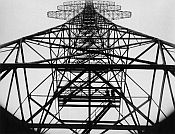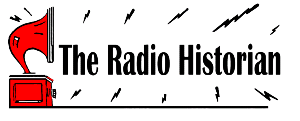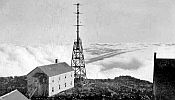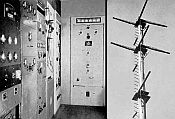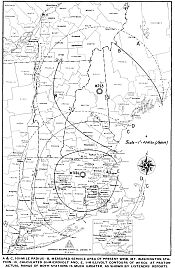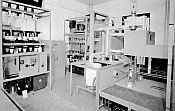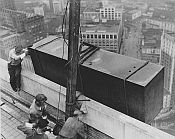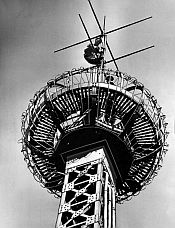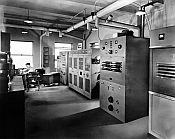|
www.theradiohistorian.org
Copyright 2018 -
John F. Schneider & Associates, LLC
[Return
to Home Page]
(Click
on photos to enlarge)
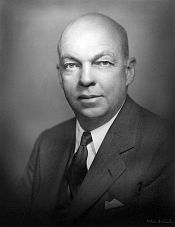
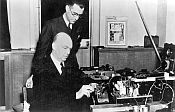
Major
Edwin Armstrong, the
inventor of wideband FM radio, demonstrates his FM receiver to
executives at
General Electric, 1939.
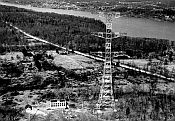
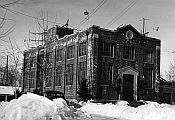
A
winter view of Armstrong's W2XMN building at Alpine, NJ. The
tower and building are still in use as a radio transmitting facility
today. (Columbia
University Library image)
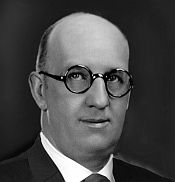
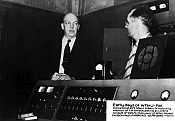
Major Armstrong,
the inventor of wideband FM, is seen visiting W9XAO during its opening
celebration in 1940.
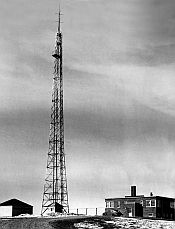
WTMJ
in Milwaukee
built this transmitter site for its station W55M in 1942. The 200 ft. tower was
situated on Richfield
Hill, 21 miles NW of Milwaukee with an elevation of 450 ft. The building
included living quarters for
the engineer/operators.
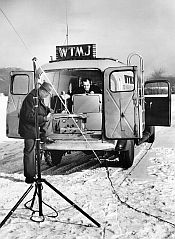
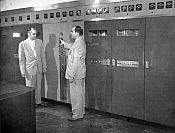
When
W55M moved up to the new FM band and became WTMJ-FM in 1948, it
installed this RCA BTF-50A transmitter. With 50 kW
transmitter power,
and 349 kW Effective Radiated Power (E.R.P.) it was one of the most
powerful FM stations in the United States. But when FM failed
to
attract an audience, WTMJ-FM was shut down in 1950.
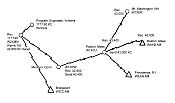

This
was the transmitter site for General Electric's FM station
W2XOY
(later renamed W57A). It was situated on the edge of a cliff
overlooking the target coverage area of Schenectady and Albany,
NY. December, 1940.
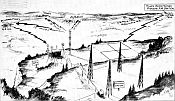

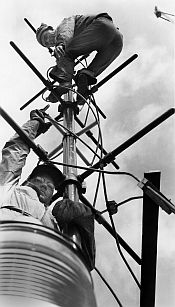
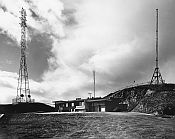
In
1949, a year after the above image was taken, NBC completed this
transmission facility on Mt. San Bruno, just South of San
Francisco. The building housed the transmitters and
engineer’s
living quarters for both KNBC-FM and the Chronicle Publishing Company’s
KRON-TV. KNBC-FM operated on 99.7 MHz with 45 kW.
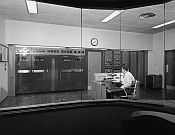
This was the RCA FM transmitter that NBC
installed at KNBC-FM in San Francisco in 1949. In the days
before transmitter remote control was allowed, an engineer was required
to be on duty at the transmitter during all hours of
operation.
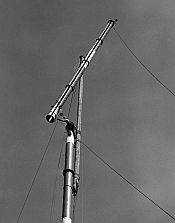
|
|
BEFORE FM, THERE WAS
APEX
In
the early and mid-1930s, radio communication was confined
to the Low Waves (100-500 kHz), Medium Waves (500-1500 kHz), and the
Short
Waves (1,500 to 30,000 kHz). The
frequencies
above that, referred to as the “ultra-high frequencies”, were truly the
“Wild
West” of radio. It
was a place for
experimentation and a possible home to future radio services. Commercial broadcasting to
the public took
place entirely on the standard broadcast band (540-1600 kHz), but it
was
affected by a number of defects that annoyed the public – natural and
man-made static,
local and skip interference, atmospheric fading, and limited fidelity. Starting about 1932, a
number of brave and
daring broadcasters sought permission from the FCC to conduct
experiments in
the Ultra-Short Waves in an attempt to find solutions to these problems. In particular, these
experimental stations wanted
to transmit wideband, high fidelity audio.
Amplitude modulation, the only known method of
transmitting audio at the
time, was the method utilized on these so-called “Apex” stations. Experimental licenses were
being issued for up
to 1,000 watts on frequencies at 25-26 MHz and 42 MHz.
By 1939, these Apex stations were operating
in 34 U.S. cities in 22 states They suffered less skip
interference than
standard AM stations, but static was still a problem.
At
the same time that these Apex broadcasters were gaining a
foothold in the upper frontiers of the radio spectrum, an entirely new
type of
radio service was also being demonstrated - one that was destined to
cause Apex
AM to become obsolete. That
service was
called Frequency Modulation, or FM.
MAJOR ARMSTRONG’S
AMAZING INVENTION
Contrary
to popular belief, Major Edwin Howard Armstrong did
not invent FM. The
first patent for
frequency modulation had been filed as far back as 1902. In the 1920’s, RCA had
experimented with FM,
and found it lacking. However,
all of this
work had been done using narrowband deviation. In
1922,
Bell Labs engineer John R. Carson published a
mathematical study that indicated
FM was less frequency efficient than AM, and subject to heavy
distortion. In his
1922 paper to the Institute of Radio
Engineers (I.R.E.), Carson wrote:
“This
type of modulation inherently distorts, without any compensating
advantages
whatsoever.” This
and other “expert”
papers effectively closed the book on further investigation of FM for a
number
of years.
Meanwhile, in
his research at Columbia University, Armstrong had long
been searching for a cure for the problem of radio static, but he had
come up
empty-handed. Once
he finally concluded
that it was impossible to separate intelligence from static with
conventional amplitude
modulation, he took another look at frequency modulation. His truly revolutionary
breakthrough was his
discovery of “Wideband FM”. Up
until
that time, all radio research had the goal of narrowing the bandwidth –
trying
to squeeze more intelligence into a smaller space.
Armstrong took the opposite approach - he discovered
that the very wide deviation of the frequency delivered vastly superior
audio performance
-- high fidelity audio and a high signal to noise ratio. Also, by spreading the
intelligence over a
larger frequency range, less transmitter power was required to achieve
the
desired range. Furthermore,
FM signals
were much more immune to interference than AM due to its “capture
effect” – an
interfering signal needed to be more than 50% the strength of the
desired
signal to cause audible interference, compared to 5% or less with AM. This characteristic would
considerably reduce
the required separation between stations occupying the same channel and
allow
more channel re-use, which compensated for its greater occupied
bandwidth. And most
importantly, because all natural and
man-made static is amplitude modulated, FM proved to be amazingly
noise-free. Armstrong
improved its
resistance to noise still further by incorporating a new receiver
component – a
limiter that stripped off the amplitude variations in the received
signal
before it reached the detector. He
had
finally solved the problem of static interference that had confounded
radio
experts since the beginnings of the art.
It would been
impossible to use Armstrong’s wideband FM
system in the commercially active radio spectrum at that time (200 kHz
to 30
MHz) – one 200 kHz wide FM channel alone occupied the space of twenty
channels
in the standard AM broadcast band.
But
the “ultra-high” spectrum above 40 MHz was virgin frontier, and it had
plenty
of room to accommodate spectrum-hungry services like FM radio and
television.
Major
Armstrong first demonstrated his revolutionary
technology privately to David Sarnoff and the engineers of RCA in 1933
and 1934. Then,
when RCA failed to show an interest in
licensing his technology, he gave his first public demonstration to the
I.R.E. On
November 5, 1935, its members heard amateur station W2AG operating in
FM at a
distance of 17 miles from the meeting location.
The following May, the IRE publishes Armstrong’s
technical paper "A
Method of Reducing Disturbances in Radio Signaling by a System of
Frequency
Modulation".
All
who heard FM for the first time were astonished at its
clarity and robustness. Nonetheless,
while
clearly superior to AM in all regards, the industry’s response to FM
was mixed. Although
light years beyond the capabilities
of standard AM broadcasting, it was not adaptable to the current
structure of broadcast
radio. FM’s
implementation would require
a complete new infrastructure of broadcasting stations and millions of
new consumer
receivers. FM could
also potentially
make obsolete more than 600 AM broadcasting facilities in the United
States,
destroying huge investments the major players had made in the
broadcasting industry. After
surviving its
financially challenging beginnings, radio broadcasting of the thirties
was
proving to be extremely lucrative, and the dominant big broadcasting
corporations were not interested in seeing FM upend their business
plans. As a result,
even as they gave positive lip
service to FM, the powerful radio interests, led principally by David
Sarnoff
and RCA, quietly aligned their strategies to suppress the deployment of
Armstrong’s FM technology.
DEMONSTRATION TO THE FCC
In 1934, RCA had
permitted Armstrong to conduct FM tests
from its facility atop the Empire State Building, but in 1936 he was
asked to
vacate to make room for television tests.
Undeterred, he requested permission from the FCC to
construct his own
high power FM station, and, although initially rebuffed by Commission
staffers,
he was finally granted permission to build a 40 kW experimental station
in June
of 1936. The
construction of this
station was a multi-year project, which included building a giant 400
ft. tower
on the Palisades at Alpine, New Jersey, near the George Washington
bridge.
Finally,
on January 11, 1939, Armstrong’s station was ready
to demonstrate FM’s capabilities to the world.
He invited FCC engineers to monitor the station at
Sayville, New Jersey,
50 miles away from the transmitter site, operating on 42.8 MHz with 20
kW. They
also listened to amateur station W2AG in Yonkers, operating on 110 MHz
with 500
watts. The
following month, Broadcasting Magazine
quoted the FCC’s enthusiastic
praise of FM –it had demonstrated “a material gain in effectiveness of
reception through static, especially the type of static resulting from
nearby
thunderstorms and from some types of man-made electrical disturbances.” The FCC was sold
on FM – so much so that
they began to authorize other experimental FM stations while halting
any
further permits for Apex AM stations.
The FCC wanted to expedite FM testing before the Apex AM
broadcasters could become too well entrenched.
THE FIRST FM STATIONS
TAKE TO THE AIR
Among
the broadcasters, Armstrong had found numerous supporters
of his technology. These
were mostly
well-heeled medium-market broadcasters that had been successful in
their
communities, but who had been shut out of the big leagues by the bigger
operators and major networks. The
adoption of FM could allow them to completely bypass the existing
broadcast
hierarchy and stake an early footing in the next big radio frontier. The first broadcaster to
establish an
experimental FM station was WDRC in Hartford, who converted their Apex
station
W1XPW in Meriden, Connecticut, to FM on May 13, 1939.
They were followed on July 18 by Armstrong’s
Alpine station, W2XMN, which began regular broadcasts on 42.8 MHz using
a
modified RCA transmitter followed by an REL (Radio Electronic
Laboratories) 40
kW amplifier. W2XMN
broadcast a daily schedule
of music from high fidelity transcriptions and relays of programs from
WQXR in
New York.
The
next station to debut, on July 24, was W1XOJ in Paxton,
Massachusetts. Its
operator was one of
Armstrong’s biggest proponents - John Shepard III, the owner of WNAC in
Boston
and New England’s Yankee Network.
From
the summit of Mt. Asnebumskit, W1XOJ broadcast sixteen hours a day with
2 kW on
43.0 MHz (this was upgraded to 30 kW in February, 1940). After its provisional
antenna was destroyed
in an ice storm that winter, W1XOJ installed a ten element turnstile
antenna on
250 ft. tower.
Broadcasters
and the public alike were amazed at the
coverage and fidelity of both the Alpine and Paxton stations, as they
delivered
studio-quality audio signals at distances that rivalled the biggest 50
kW AM
stations.
Shepard
was passionate about FM, and he spared no expense to
make his Paxton station a first-class operation.
W1XOJ was on the air from 8 AM to midnight
daily, with programs selected from Yankee, Colonial, NBC Blue and
Mutual
Networks. Because
the standard
broadcast-grade network phone lines just passed audio frequencies below
5 kHz,
Shepard ordered a special 8 kHz “hi fi” network line between New York
and
Boston. He also
broadcast four hours of
local studio programming daily to provide full 15 kHz fidelity. And instead of using
broadcast phone lines to
link the Boston studios to the Paxton transmitter, 43 miles distant, he
installed a second FM transmitter at the studio, operating with 250
watts on
133.03 MHz – one of the first wireless studio-transmitter links.
These
three pioneer FM stations were facing one very substantial
obstacle – there were only 25 FM receivers in the entire world at that
time –
all hand-built to Armstrong’s specifications.
Receiver manufacturers would not commit to making FM
radios until the FCC
made FM an officially-sanctioned technology.
The
Commission conducted a series of hearings about FM
during March and April of 1940. The
often contentious proceedings pitted the proponents of Armstrong’s
wideband FM
system against RCA and other interests that favored a narrowband FM
approach --
leaving more spectrum for the development of television. Finally, on May 20, 1940,
the FCC officially
authorized commercial FM broadcasting.
To the shock of RCA and other television proponents,
the commission reassigned
TV Channel 1 – 42 to 50 MHz - creating 40 exclusive channels for FM
radio. All
experimental Apex AM licenses were
terminated, and those broadcasters were encouraged to apply for new FM
licenses. The
Commission even chose FM as
the modulation method to be used for television sound.
It was a complete victory for the Armstrong
interests and a major setback for RCA and the television proponents.
Shortly thereafter
(June 22), the commission released the new regulations governing FM
broadcasting. . Of the 40 new channels, seven (43.1
to 44.3) were reserved for large cities; and six (48.9 to 49.9) for
small communities. Multiplexing and facsimile were
permitted. The stations were required to transmit a minimum 6
hours per day except Sundays, and this was to include a minimum of one
daytime and one evening hour of non-duplicated full fidelity programs.
FM TAKES OFF
A
wave of FM excitement immediately swept over the broadcast
industry, and the FCC was deluged with more than 150 applications for
new FM
stations. On March
1, 1941, the
Commission issued its first commercial FM license to W47NV Nashville
(WSM). Meanwhile,
the Apex stations began
shutting down or converting to FM in droves.
The first to convert was WTMJ in Milwaukee, whose
experimental FM station
W9XAO debuted five days before the FCC’s decision.
When the new regulations went into effect, it
became W55M on 45.5 MHz with 10,000 watts, programmed entirely separate
from
WTMJ-AM. W55M operated from a new site constructed 21 miles northwest
of Milwaukee, with a high fidelity phone line connecting it back to the
company’s new half million dollar studio facility.
The FM building included living quarters for on-site engineers
(unattended remote control of transmitters was not yet
permitted). The Journal’s vice president of broadcasting,
Walter J. Damm, was one of FM’s most enthusiastic supporters, and in
1942 was elected president of the FM Broadcasters, Inc., a trade
association of FM broadcasters that was later absorbed into the NAB.
Over
in
Michigan, the Detroit
News shut down its Apex station W8XWJ after four years of operation and
applied
for a new FM license on 44.5 MHz. The
station, W45D, broadcast from an antenna atop the Penobscot Building,
the
highest structure in Detroit, and was programmed separately from its
sister AM
station WWJ from studios in the Penobscot building.
(W45D can be directly traced to today’s WXYT-FM in
Detroit.)
Another
early adopter was the General Electric Company, which built its
high-powered FM station W2XOY (later W57A), in the Helderberg
Mountains, twelve miles south of Schenectady. GE
simultaneously announced plans to manufacture both FM transmitters and
receivers. And there was the experimental station W2XOR,
operated by WOR in New York, which later became W71NY. It
broadcast from 8:00 AM to 11:30 PM daily with a 10 kW transmitter from
42nd floor of 444 Madison Avenue. Its programming was a mix
of WOR and Mutual programs, with 65% of its time dedicated to separate
W71NY programs or high fidelity transcriptions. It was
connected by land line to the WOR studios, just 4,000 feet away,
although the station even experimented with a light beam link between
the two locations.
The
FCC had devised a unique call sign system for these
commercial FM stations. It
was a
combination of numbers that indicated the frequency, and letters
identifying
the city. For
example, W55M was on 45.5
MHz in Milwaukee; W47NV broadcast on on 44.7 MHz in Nashville; and
K45LA was on
44.5 MHz in Los Angeles. The
dials of
most receivers indicated channel numbers instead of the frequency –
tuning from
channels 21 to 99.
Most
of the early adopters were AM stations that were
protecting their interests in case FM should supplant AM. Their only investment, in
most cases, was the
purchase of an FM transmitter and antenna, and some studio upgrades to
accommodate
the higher fidelity needed by FM.
This
was a boon for the equipment manufacturers – principally REL, G.E. and
Western
Electric. Many of
these FM stations just duplicated the programming of AM sister stations
except for the required two of separate programming
daily. This
was
mostly fulfilled with live studio
broadcasts or high fidelity transcriptions.
The
receiver manufacturers were early supporters of FM, and
models were available from GE, Stromberg-Carlson, Philco, Meissner and
Pilot at
prices ranging from $50 to $200. These
were mostly combination AM/FM/SW sets, both tabletop and console
models, and
there were a few FM-to-AM tuner converters. The FM tuners in these
early sets
suffered from poor sensitivity, difficult tuning, and a tendency to
drift off
frequency. RCA also
entered the FM
receiver market, but they refused to pay license fees to Armstrong,
declaring
that their proprietary “ratio detector” design was based on different
technology (it was later found to violate two Armstrong patents).
FM NETWORKS
One
of the most promising facets of FM broadcasting was its
ability to create wireless regional networks by relaying the programs
captured
off air from other FM stations. Because
of FM’s superb audio quality, a program could be passed between
stations in
multiple hops and still have a quality that was vastly superior to the
big AM networks. In
January, 1940, a program was relayed in
six hops from Yonkers to Alpine, to Meriden and on to Worchester,
through
Paxton and Mount Washington and finally it was broadcast by a Boston AM
station. This
prospect was another
confidence-shaker for the big time broadcasters, who were paying huge
sums to
AT&T for their network lines.
These
high distribution cost, plus the limited availability of these lines,
gave the
national networks a semi-monopoly by restricting the entry of others
into the
network business. But
now, groups of
modestly-financed FM stations could form an alliance to create regional
and
even national networks having much better audio quality at a
substantially
lower cost! This
possibility represented
a colossal threat to the big AM networks as well as to AT&T.
Special
relay receive sites with high-gain directional
antennas were usually required for best performance of these FM program
relays. For its
needs, General Electric built a
separate mountaintop receive site 200 ft. higher and 1-1/2 miles south
of its W57A
transmitter site in Schenectady, which reduced potential interference
from its
own transmitter. With
this arrangement,
GE regularly rebroadcast programs from Major Armstrong’s Alpine
station, 129
miles distant. In
turn, GE’s
rebroadcasts of these programs were being passed on for rebroadcast by
another six
stations.
In
Boston, John Shepard was busy establishing a New England FM
Network. He built an additional 5 kW FM station, W1XER (later
W39B) located atop Mt. Washington in New Hampshire At 6,288
ft. above sea level, it sat atop the highest peak on Atlantic
coast. Debuting on December 18, 1940, W1XER
repeated programs received off-air from Paxton, and it was said to lay
down a good signal from Maine to Boston. The
facility was designed to survive the extreme weather conditions at
Mount Washington – it used a two-element turnstile antenna whose dipole
elements were constructed from truck springs to withstand the heavy
rime icing.
IT WAS A VERY GOOD
YEAR
1941 saw remarkable growth in FM
broadcasting. By March, there were 22 commercial stations on
the air, with 70-more under construction or awaiting FCC
authorization. (Most in this latter group were just waiting
for equipment deliveries, which were proceeding at a snail’s pace –
only GE and REL were shipping FM transmitters.) It was
predicted that, by end of 1940, more than 60% of the U.S. population
would be within range of at least one FM station.
Many of the big AM broadcasters around the country were now jumping on
the FM bandwagon. They included WTIC in Hartford (W53H), WGN
in Chicago (W59C), WBZ in Boston (W1KX Boston and W1XSN Springfield),
both NBC and CBS in New York (W51NY and W67NY), WHAM in Rochester
(W8XVB, owned by Stromberg-Carlson), WFIL in Philadelphia (W53PH), and
KHJ in Los Angeles (K45LA).
In Chicago, the Zenith Corporation opened the city’s first FM station,
W9XZN (later W51C and then WEFM). The company had been out of
the broadcast business since the Federal Radio Commission deleted its
Chicago station WJAZ back in 1931, but it now saw good business
potential in the FM receiver market. It debuted in 1939 with
a custom-made water-cooled 50,000 watt transmitter, broadcasting from
the 45th floor of the Field Building at 135 S. LaSalle St.
W51C broadcast sixteen hours a day on 45.1 MHz, playing “only good
music” from specialized high-fidelity transcription disks, ranging from
classical to Latin music, to Gilbert and Sullivan.
There was no advertising except for one announcement each hour
promoting Zenith products. Program guides were sold to the
public on a subscription basis.
Growth on the receiver side was equally encouraging – the number of
units in consumers’ hands grew from 15,000 at the end of 1940 to
180,000 by the following December. By now, 29 different
manufacturers were offering more than 100 models of receivers.
Clearly, FM had gained major ground in 1940 and 41, and all indicators
pointed to it being the future direction for radio. There
were predictions that many AM stations would move over to the FM
band. It was also attracting a good number of would-be
broadcasters that had been shut out of the field by a lack of available
AM channels in their communities. Because the FCC was
proposing to open every other channel for usage in the same community,
the number of possible stations could exceed market demand in many
areas of the country.
This possibility of explosive FM growth alarmed the radio
establishment. But by mid-1941 the tide was beginning to turn
on several fronts. It was already becoming clear the 42-50
MHz FM band was too small to meet the perceived demand for FM
stations. By February of 1941, the FCC had already received
ten applications for the remaining four available channels in New York
City, and it foresaw similar difficulties in other major
cities. Additionally, the FCC was becoming concerned with the
concentration of media ownership in the hands of a few, and so it
stopped accepting radio applications submitted by newspaper
interests. This caused a number of planned FM operations to
halt in their tracks. If these issues weren’t enough to slow
FM’s growth, there was that pesky war over in Europe …
WAR
STOPS FM
DEVELOPMENT
Even
before Pearl Harbor, US manufacturers were increasingly
being drawn into producing arms for the European allies and some raw
materials
and essential electronic components were becoming scarce. Then, after December 7,
all manufacturing of
broadcast equipment ended, as the electronics industry geared up for
wartime
production. Thirty
manufacturers of
radio sets ceased all civilian production.
The FCC institutes a freeze on new licenses or
changes of operations
because of wartime material shortages.
Those
broadcasters who had already received permits were allowed to continue
building
their stations, but in most cases the needed materials were simply not
available. Additionally,
there were
staffing shortages as many experienced announcers, musicians and
engineers
headed off to war.
In February,
1942, there were 31 FM stations on the air:
|
Baton Rouge
– W45BR (WJBO)
|
Mt.
Washington – W39B (Yankee Net)
|
|
Boston –
W43B (Yankee Network)
W67B (WBZ)
|
Nashville –
W47NV (WSM)
|
|
Chicago
–W51C (Zenith)
W59C (WGN)
W67C (CBS)
W75C
(Moody Bible)
|
New York–
W47NY (Muzak)
W2XMN (Armstrong)
W51NY
(NBC)
W59NY
(WQXR)
W67NY
(CBS)
W71NY
(WOR)
|
|
Columbus, OH
– W45CM (WBNS)
|
Philadelphia
– W53PH (WFIL)
W69PH
(WCAU)
|
|
Detroit –
W45D (WWJ)
W49D
(WJLB)
|
Pittsburgh –
W47P (Walker-Downing corp.)
W75P (Westinghouse, KDKA)
|
|
Evansville,
IN – W45V (WEOA)
|
Rochester
–W51R (Stromberg-Carlson)
|
|
Hartford –
W53H (WTIC)
W65H (WDRC)
|
Schenectady
– W47A (Capitol Broadcasting)
W57A
(General Electric Co.)
|
|
Los Angeles
– K45LA (KHJ)
|
Springfield,
MA W81SP (WBZA)
|
|
Milwaukee –
W55M (WTMJ)
|
|
They
all
committed to maintaining their operations and programming schedules,
but the
further development of FM essentially stopped during the war.
In
1943, the FCC’s FM call letter system was found to be
difficult to administer and confusing to listeners.
The system was abandoned, and all stations
were reassigned standard four-letter call signs.
FM stations owned by AM broadcasters were
allowed to affix “–FM” to end of the AM station’s call sign.
At
the war’s end, there were 46 FM stations on the air
nationwide. Another
430 applications
were on hold, waiting for the FCC to end the freeze and renew the
growth of the
service. But people
and their attitudes
had changed at the FCC during the war -- it was no longer the
FM-friendly
agency of four years earlier.
Even
as the war was being fought, RCA and other interests
were continuing the development of television.
Once the end of the war was in sight, it was obvious
that post-war TV was
going to have tremendous consumer appeal, and its promoters felt FM’s
spectrum
allocation was robbing essential frequencies that would be needed for
television. In the
war’s final year, big industry, led principally
by RCA, was working quietly behind the scenes to undermine FM’s
position. During
the war, manufacturers and government had
worked closely together to equip the armed forces with electronics
systems that
helped win the war, and so the relationship between industry and
government was
very tight. Over at
the FCC, a steady
stream of lobbyists made its way to its offices, and the
industry-friendly
commissioners were all too happy to receive them.
The interests aligned against FM were concealing
a strong poker hand, and they planned to play their cards as soon as
the war
ended.
POST-WAR FREQUENCY MOVE
CRIPPLES FM
In
1945, the FCC began a series of hearings into the
post-war use of the high frequency spectrum.
On January 15, 1945, the FCC announced its proposal
to move FM band to
88 to 108 MHz so it could reassign the pre-war FM band to television. A bitter battle
ensued, with the FM interests
fighting the television interests, and with the FCC apparently
entrenched in
the TV camp. Then a
new issue was raised
by the FCC. Pre-war
FM had operated
during a sunspot minimum, and the next maximum was to occur in 1947. The FCC was worried that
sunspot disturbances
could cause propagation interference in old FM band. To
investigate the issue, the FCC hired a War
Department engineer named Kenneth Alva Norton.
Based entirely on mathematic calculations, and
unsupported by any field
tests, Norton proclaimed that the 42-50 MHz band would suffer between
830 and
2,410 hours of tropospheric and Sporadic E propagation interference per
year
because of sunspot disturbances. He
supported
the FCC’s plan to move FM upward in the spectrum where it could enjoy a
relatively interference-free service.
There
were fundamental errors in Norton’s calculations, and Armstrong and
other FM
proponents pointed them out. The
FCC
then scheduled engineering hearings where the testimony of Norton could
be
challenged by Armstrong and his supporters. But
the hearings were held in secret - no
outside observers were allowed, and no transcripts of the hearings were
made. In the end,
politics won out over
engineering, and the FM band was moved “upstairs” to make more room for
television. In two more years, when the 1947 sunspot peak proved that
Norton’s
calculations had been wrong, the move had already taken place and the
issue was
past
history.
The
new 88-108 MHz band did not enjoy the long-range
propagation of the old 42-50 MHz band, and three times the transmitter
power was
required for the same coverage. In
addition to this setback, the FCC further hindered FM by accepting a
CBS proposal
to reduce allowable transmitter powers, limiting coverage to single
markets
instead of entire regions (conveniently hampering the possibility for
regional
off-air networks.) It
also allowed combined
AM/FM operations to fully duplicate AM their programming on FM. This had the result of
eliminating most
separate FM programming – and took away a major incentive for the
public to
purchase FM sets. These
three moves by
the FCC combined to deal a serious setback to FM – one that it would
take 20
years to recover from.
Some
of the existing FM broadcasters transitioned to the new
band, while others just left the air.
A
few broadcasters chose to operate simultaneously on both bands until
the FCC
shut down the old band completely in 1949.
Because of the time needed for the electronics
industry to retool for peacetime,
transmitters and receivers for the new FM band did not become available
until
1947. Once the backlog of FM applications began to be approved by the
Commission on the new band, the number of FM stations began to slowly
climb, up
to 140 stations by the end of 1947.
One
of the few positive aspects of the FCC’s band change was
its reservation of 88-92 MHz for educational broadcasting. After years of being
generally shut out of
broadcasting, colleges and universities were happy to take advantage of
this new
opening, and the educational stations they built would enjoy the most
success
during FM’s next 15 years. The
range of
92 to 106 MHz was assigned to commercial FM station, and 106-108 MHz
was
reserved for radio facsimile, but this last segment was later
reassigned to FM
radio when facsimile failed to gain popular acceptance.
Still,
FM had suffered a major setback which affected both
broadcasters and listeners. 46
transmitters and 400,000 pre-war FM receivers had been rendered
obsolete. Although
some converters were sold that
allowed low-band FM sets to receive the new frequencies, they were
complicated
to install and often more expensive than a new set.
FM WITHERS AND DIES
By
the end of 1949, over 600 FM stations were on the air,
but they were discovering that the listeners were not there. Post-war consumers were
spending their money on
television sets, and the sales of both AM and FM radios stagnated, as
shown by
these figures:
|
YEAR
|
TV
|
AM
|
FM
|
|
1947
|
14,000
|
1,362,000
|
98,000
|
|
1948
|
72,000
|
973,000
|
132,000
|
|
1949
|
201,000
|
532,000
|
73,000
|
|
1950
|
507,000
|
827,000
|
103,000
|
|
1951
|
412,000
|
964,000
|
82,000
|
|
1952
|
508,000
|
738,000
|
35,000
|
In competition with the public’s enthusiasm for
television, FM
was simply unable to recover from the wartime freeze and change in
frequencies.
The number of
stations would reach a
peak of 700 in 1952, and then begin to slowly decline because of
negative
economics. 210 FM
stations were deleted
in 1949 alone, and 25 more in the first three months of 1950. WTMJ in Milwaukee, one of
the medium’s
biggest early proponents, threw in the towel in 1950, closing its FM
station
WTMJ-FM, and sister station WSAU-FM.
The
company notified the FCC of the stations’ closings in a letter, citing
a lack
of FM receivers as the principal cause.
“FM,”
they said, “has not lived up to its bright promise of ten years ago. Failure of the public to buy
the anticipated
number of receivers convinced the owners that continued operation would
not be
a worthwhile undertaking.” With
there
being almost no marked for used FM transmitters, many of the closing
stations
donated their equipment to colleges and took a tax write-off. In Seattle, Fisher
Broadcasting closed its
station KOMO-FM, and donated all equipment to the University of
Washington, giving
birth to the educational station KUOW.
The
nadir of FM radio’s existence was reached between 1953
and 1956, with numerous stations leaving the air and public interest
being almost
non-existent. These
were also dark years
for FM’s inventor, Major Edwin Armstrong -- most of his FM patents had
expired
in 1950, and his licensing income was dwindling because of the downturn. Further, RCA had
steadfastly refused to pay him
any licensing fees, despite the fact that they were manufacturing both
FM
transmitters and receivers. Years
of
never-ending litigation against RCA and the corresponding legal fees
drove him
close to bankruptcy. Finally,
on
February 1, 1954, at the age of 63, he took his own life, jumping out
the
window of his 13th floor Manhattan apartment. RCA eventually settled and
paid off
Armstrong’s widow.
The
FM stations that did not succumb to the FM downturn found
ways to survive as best they could.
Many
were sister stations to profitable AM broadcasters who paid the bills. Others survived by
distributing background
music to stores and offices, transmitted on multiplexed subcarrier
channels. Programming
in the 1950’s was
mostly “good music” and classical, with only occasional commercials. As
previously mentioned, educational and school stations were the most
successful FM
operators, filling a demand for educational radio that had been mostly
denied them
on the AM band. In
1951, schools and
colleges were operating 100 FM stations in 34 states.
FM’s RESURGENCE
1957
was first year that number of stations on air increased
over prior year. This
improvement was
being driven by multiplexed subcarrier services, better FM receivers
(now incorporating
an AFC circuit), and increased interference on an increasingly
overcrowded AM
band. Another
factor that gave FM an
important boost was the upsurge in the public’s interest in high
fidelity audio
in the late 1950’s. There
was growing
public interest in stereo or “binaural” audio recordings, and
combination AM/FM
broadcasters were able to tap into this trend by broadcasting one
channel on
the FM band and the other on the AM band.
A few manufacturers even produced specialized AM/FM
receivers to pick up
these programs. Finally,
on April 24,
1961, the FCC authorized the multiplex stereo that had been created by
Zenith, which
greatly increased the public’s interest in FM.
Three years later, the FCC gave FM another shot in
the arm by requiring
AM/FM broadcasters in cities over 100,000 population to transmit
separate
programming half of the day. This generated a greater variety of
programming
for FM listeners. To
minimize costs, many
AM stations hired young novice announcers to run their FM stations and
gave
them free rein on programming. The
free-form
music formats they created, often based on longer album cuts instead of
hits, appealed
to a younger audience by offering music that could not be heard on the
Top 40
AM stations. This
young audience developed
a preference FM over AM, and as they matured into adulthood over the
next
twenty years, they never lost their FM radio habits.
In the 1970’s, FM was finally competitive
with AM, and by the 1980’s it was the dominant radio medium. In 1982, FM commanded 70%
of the total U.S.
audience and 84% among the 12- to 24-year-old demographic. When the program duplication
rule was repealed
in 1986; it was the AM stations that needed help to stay competitive.
POST SCRIPT
In
the end, the superior capabilities of Major Armstrong’s
system of frequency modulation triumphed over the entrenched interests
that had
tried to suppress it. Even
though they successfully
set back FM’s growth for twenty years, in the end its tremendous
technical and
sonic advantages could not be denied.
One
wonders what would have happened if FM had been allowed
to continued its trajectory on the original 42-50 MHz band. On one hand, the pioneer
stations enjoyed
greater coverage than today, as that band was less subject to
line-of-sight
limitations. On the
other hand, we know
that the old band would have probably suffered more ducting and E-layer
skip
interference. Anyone
who is familiar
with the amateur radio 6-meter band at 50 MHz knows that there would
have been
significant interference whenever skip was “in”.
FM
broadcasting is also better off today because the band
change increased FM’s available spectrum almost threefold, giving us
100
channels instead of the original 40.
As
was already being detected in the early 1940’s, FM’s growth would have
eventually
been stifled by a lack of frequencies. Assigned
to a spectrum sandwiched between military frequencies and the low VHF
TV
channels, there would have been no room for FM broadcasting to expand
to meet
the eventual demand. Today,
as the
standard AM band becomes increasingly neglected and handicapped in our
high-noise digital world, even the present 88-108 MHz band is being
stretched
beyond its capacity in many parts of the country.
The
future course of radio broadcasting is uncertain today.
The public now has many more options for
aural information and entertainment than it did twenty years ago. We now have our choice
between analog and
digital AM/FM radio, satellite radio, and streaming Internet music fed
through
our phones and smart speakers – all of which serves to fractionalize
the
audience into smaller and smaller parts.
Nonetheless, it seems likely that FM radio
broadcasting will still be a
major source of entertainment and information for at least one more
generation
of listeners.
RESOURCES:
Man
of High Fidelity:
Edwin Howard Armstrong, by Lawrence
Lessing, Lippencott Company,
1956
Empire of the Air
by Tom Lewis, Burlingame Books, 1991
Proceedings of the
Institute of Radio Engineers, May
1936 (Vol. 24, no. 5): “A
Method of
Reducing Disturbances in Radio Signaling by a System of Frequency
Modulation”,
by Edwin H. Armstrong.
FM Magazine:
- “FCC
Rules Governing High Frequency Broadcast
Stations”, Nov. 1940
- “Description
of Yankee Network’s W1XOJ at
Paxton”, Nov. 1940
- “Planning
an FM station”. Feb. 1941
- “What
Broadcasters Have to Say: Walter
J. Damm”, Feb. 1941
- “FM
Featured in $500,000 Plant”, Feb. 1941
- “More
FM Service in New England”, April 1941
- “Status
of FM Broadcasting”, April 1941
- “What the
Broadcasters Have to Say: W45D
Detroit”,
July 1941
- “What
the Broadcasters Have to Say: W71NY
New York”, June 1941
- “W71NY
is Model Installation”, Dec. 1941
- “GE
Backs Broadcasting”, March 1942
- “War
Revises Radio Industry”, April 1942
- “FM
Broadcast Stations On The Air”, February
1947
- “US
Educational Stations” March 1951
- “TV,
AM, FM Set Production” various issues
Broadcasting
Magazine:
- “Armstrong
soon to start staticless radio”,
2-1-39
- “Traffic
jam confronts FCC in allocating FM facilities”,
2-17-41
- “FCC
newspaper ownership freeze”, 3-24-41
- W9XAO
becomes W55M, 4/21/41
- “FCC
authorization for 53 commercial outlets
given”, 8-18-41
- “No
Curtailment Planned by W55M”, 10/26/42
- “FM
Broadcasters Pledge Action” 8/9/43
- Testimonies
to FCC re proposed band change,
2/26/45
- “FCC
announces FM and TV reallocation plan”, 1-16-45
- “FCC
allocates 88-106 band to FM”, 7-2-45
- “Second
FM Shift”, 8/6/45
- “WTMJ
Drops FM”, 4/30/50
“Amendment
of Section 73.242 Rules Regarding Program
Duplication”, FCC Report and Order 4-4-1986
“The
Milwaukee Journal” 12/28/41: “It
Looks Like a Happy New Year in FM Field”.
“FM
Broadcasting Chronology” by Jeff Miller,
http://jeff560.tripod.com/chronofm.html
“WTMJ-FM: A Case
Study in the Development of FM Broadcasting”, by Christopher H. Sterling
Wikipedia https://en.wikipedia.org/wiki/FM_broadcasting_in_the_United_States
NOTE:
This article appeared in the Spectrum Monitor Magazine, December, 2018
www.theradiohistorian.org
John F. Schneider & Associates, LLC
Copyright, 2018
|


